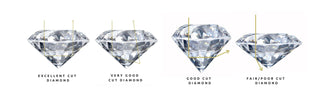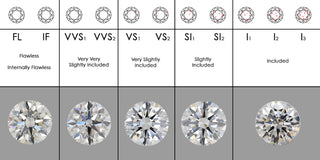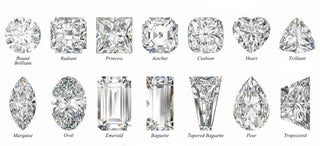Diamond buying guide
There are many factors to consider when choosing the perfect diamond for your engagement ring. The friendly, professional team at Carats are always happy to talk through the options with you - for now, here are some insights into the possibilities to consider and why they matter.
Earthly Treasures
All of Carats stones, Diamond and coloured gems are real. Natural Crystal's millions of years in the making. Special gifts provided by nature. Carats do not sell mandmade or lab/factory created diamonds, as we believe in the mystery and romance of owning something special, given by the earth to your someone special.
The 4 C's
You may have heard about the 4 C's when it comes to diamond buying. Cut, Clarity, Colour and Carat. All of Carats diamonds over .50ct will come with certification in the form of a GIA (Gemological Institute of America) certificate or other internationally trusted certification so that you can trust that the diamond you choose is the diamond you receive. Additionally, a diamond engagement ring from Carats will come with a full, independent valuation by a registered New Zealand jewellery valuer.
the cut
Refraction is the change of a light rays direction when it passes through matter - the single most important aspect to choosing a natural diamond is how well it is cut.
A well cut diamond will throw out an abundance of light and scintillating fire; this is the result of refraction.
When a diamond is cut to perfect or near perfect proportions, the light that enters into the stone through the top/table will bounce off the internal walls, resulting in light coming back up (like a mirror) through the top of the stone once again.

Clarity
In short, the clarity scale of a diamond is an indication of the size, position and type of inclusions/mark's in a diamond. Nearly all natural diamonds have these inclusions that were formed in the earth when the diamond was created millions of years ago.
At Carats, we recommend the clarity grade SI2 as a minimum for round brilliant cut and princess cut diamonds.
Higher clarity is generally recommended for stones with less facets like Emerald cut diamonds, carre cut and baguette cut diamonds.

Colour
The diamond colour grade starts at colour D. This is the whitest diamond possible. The colorless range is D,E,F and the near colorless range is G,H,I,J colour. As you go further down the alphabet, you get more colour ( generally yellow-brown) coming into the stone. Carats generally recommend as close to colourless as possible. Though going down the scale can get you a bigger diamond for your budget.
Carat
A Carat is a measure of weight used to weigh diamonds and coloured gemstones. It is important to remember that the cut of a diamond needs to be considered when looking at the weight, if a stone has a bad cut grade it will generally be deeply cut which, while weighing heavy, will not be as large looking from the top as a well cut stone.
We choose triple excellent cut diamonds.
Excellent cut, excellent symmetry and excellent polish.
Shape
While the round brilliant cut diamond is still the most popular diamond cut. There are some other cuts that are beautiful and should be a consideration when choosing your diamond engagement ring. These cuts/shapes include the Oval cut diamond, Princess cut diamond, Cushion cut diamond, Emerald cut diamond, Radiant cut diamond, Marquise cut diamond, and lesser known Carre cut, Baguette, Heart, and trillion cut diamonds.While the Emerald cut, Carre cut and Baguette cut have a shimmer with flashes of light and colour from their fewer facets. The Round brilliant, Oval, Princess, Radiant, Cushion, Heart, Marquise, and Trillion cut diamonds have more "brilliance" due to more facets cut into the stones

